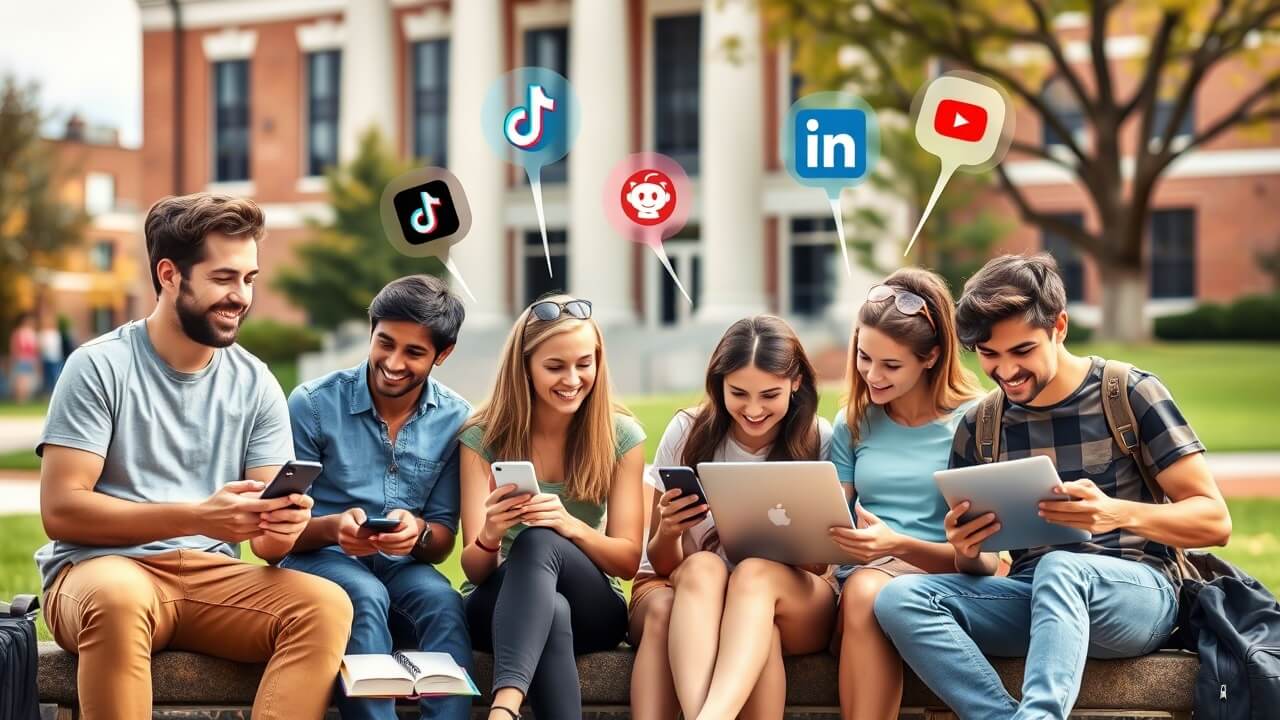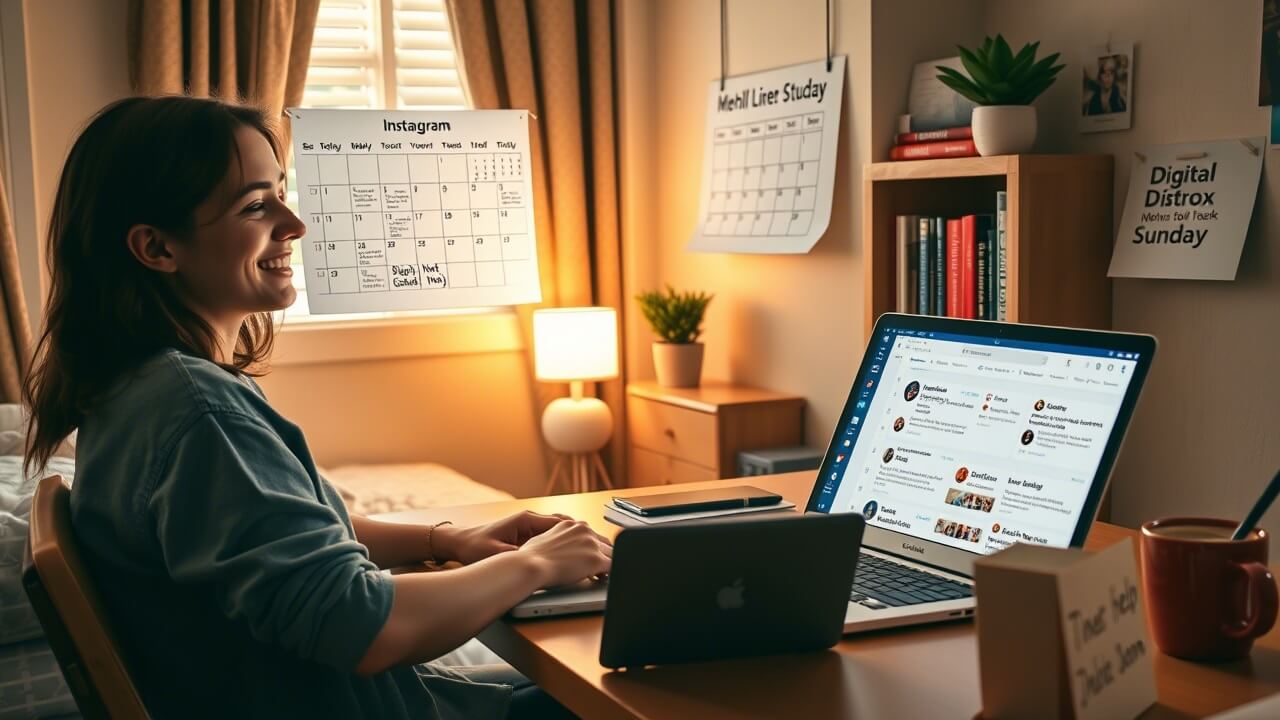
Walk through any college campus, and you’ll spot it instantly—heads down, screens glowing, fingers tapping away. It’s not unusual anymore; it’s routine. Social media is everywhere in college life. But why? What keeps students so attached to these apps?
The truth is that college students have a variety of reasons for diving into platforms like Instagram, TikTok, Twitter, Snapchat, and Facebook throughout the day. From staying in touch with friends and family to collaborating on class projects to winding down after a stressful day – social media serves many purposes in a student’s life. And it’s not just an American phenomenon; it’s global. As of 2024, about 5.1 billion people (over 62% of the world’s population) use social media, and young adults are leading the charge.
If you’re a college student, you might recognize your habits for the reasons below. If you’re a parent or educator, understanding these motivations can help you see social media through students’ eyes. This article explores why college students use social media – backed by research, expert insights, and real examples – and how it impacts their lives. We’ll also touch on the benefits and pitfalls of this digital ubiquity and share tips for balancing online and offline life.
We’re about to unpack the real reasons behind this digital habit. From staying connected and relieving stress to studying and career-building, social media plays a more significant role in student life than most think. This guide explains how and why—with stats, real examples, and practical advice.
Table of Content
- How Social Media Became Part of Daily Student Life
- Staying in Touch with Family and Friends
- Finding Connection on Campus
- Staying Updated with News and Campus Life
- Academic Support and Group Work
- Stress Relief and Fun
- Self-Expression and Personal Identity
- Career Development and Networking
- Emotional Support and Mental Health
- FOMO and Peer Pressure
- Benefits of Social Media for Students
- Challenges and Drawbacks
- Tips for Healthy Social Media Use
- How Colleges Are Supporting Smart Use
- Final Thoughts
- FAQs

How Social Media Became Part of Daily Student Life
From Casual Use to Constant Companion
In the early days, social media was just something to check occasionally. But now, it’s integrated into daily routines. According to the Pew Research Center, over 98% of 18–—to 29-year-olds use social media daily, making it one of the most common digital behaviors in this age group.
Whether scrolling through Instagram on the bus or watching study tips on TikTok before class, social media isn't just a tool anymore—it’s part of how students communicate, learn, socialize, and even plan their futures.
Why It Feels Natural
This generation didn’t just grow up with social media—they matured with it. By the time most students enter college, they’ve been using social platforms for a decade or more. So it’s not surprising that these platforms feel like second nature. It’s their go-to for news, updates, connection, and emotional support.
Staying in Touch with Family and Friends
Closing the Distance
Moving away from home can feel disorienting. But social media bridges that gap in real time. Apps like WhatsApp, Snapchat, and Instagram keep students connected with family and lifelong friends, helping them feel less far from home.
A student might send a morning “good luck” selfie to their sibling before an exam, drop a meme into a family group chat, or video call their parents after a rough day. These tiny moments help students maintain emotional bonds without making a big deal.
Maintaining Old Friendships
Graduating high school often means spreading out to different cities or even countries. Yet, former classmates remain present through likes, comments, and quick messages. It’s easier to stay close when you’re still part of each other’s daily scroll.
A UCLA student survey found that 72% of first-year students relied on social media to ease homesickness. This is not surprising, considering how familiar faces in a feed can feel comforting when everything else is new.
Finding Connection on Campus

Building New Friend Groups
Joining a new college means starting from scratch socially. Social media helps smooth that process. Many schools even create “Class of” Instagram pages or Discord channels where incoming students can introduce themselves before they ever arrive.
It helps students break the ice. A quick follow-up or like on someone’s dorm move-in picture can spark real-life conversation. In smaller groups, like clubs or study programs, GroupMe or WhatsApp chats keep people in sync.
Spaces for Belonging
For students from marginalized backgrounds—whether based on identity, language, or culture—social media can provide safe spaces they might not find easily offline. LGBTQ+ students, first-gen learners, or international students often form online communities that offer solidarity, advice, and encouragement.
These interactions might begin digitally but often lead to real friendships, events, and peer support networks.
Staying Updated with News and Campus Life
Skipping the Newsstand
College students mostly ignore traditional newspapers and nightly news. Instead, they turn to social media.
Twitter (now X), Reddit, and TikTok deliver fast, personalized updates—whether it's global politics, celebrity news, or the latest trend. According to the QS Student Survey, “keeping up with current events” was the top reason students use social media.
Campus Announcements and Local Info
Beyond world news, students also get campus-specific information from social media. Dining hall hours, guest speaker events, and safety alerts are often shared through a university’s official Instagram or Twitter page. Even professors sometimes share reminders via class Facebook groups or course-specific Discord servers.
This convenience keeps students plugged in and informed—even without checking their email.
Academic Support and Group Work
A Digital Study Partner
Social media can be surprisingly helpful in academics. In a study published in the Journal of Educational Computing Research, over 80% of students said they used social media for academic collaboration.
Students set up class group chats, sent reminders, posted study guides, and helped each other with questions they didn’t catch in the lecture. It’s like having a class forum in your pocket.
Peer-to-Peer Learning
A psychology major might find a TikTok explaining cognitive bias in 30 seconds better than a textbook chapter. A computer science student might turn to a subreddit for help debugging code.
These quick exchanges, memes, explainer videos, or shared documents can reinforce classroom learning in easy-to-digest formats.
Stress Relief and Fun
The Break Everyone Needs
College is demanding. There’s always a test, assignment, or reading list waiting. So, students use social media to relax and recharge. A funny TikTok video, a cooking tutorial on YouTube, or a relatable meme can instantly lift the mood.
According to Common Sense Media, 62% of students say social media helps reduce stress. That matters when you’re juggling five classes and a part-time job.
Just for Laughs
Humor plays a significant role. Inside jokes, campus meme pages, parody accounts, and reaction videos give students an outlet. Even five minutes of laughing during a stressful day can make a difference.
But it’s easy for short breaks to stretch longer than intended. That’s where balance comes in.
Self-Expression and Personal Identity
Sharing Who They Are
College is a time when people figure themselves out. Social media helps them do that. It allows students to post their art, share their opinions, talk about their passions, or just explore who they are becoming.
Instagram is the new portfolio. Twitter becomes a space to voice ideas. TikTok is a place to entertain, educate, or connect with niche communities.
Confidence Through Posting
Posting about achievements—like finishing a big project or landing an internship—helps students feel proud and seen. Comments, likes, and shares offer social affirmation, which can boost confidence.
That said, when people only post highlight reels, others may feel like they’re falling behind. It’s a balancing act between expression and perception.
Career Development and Networking
Getting Professional Early
As college progresses, students become more intentional about their social profiles. LinkedIn has become a hub for networking, showcasing internships, and connecting with professionals.
According to LinkedIn, 70% of students build their networks before graduation. Some create blogs, public Twitter accounts, or Instagram portfolios that align with their future careers.
Passive Job Hunting
Recruiters often search for students on LinkedIn or see their activity on Twitter threads and forums. An active, authentic presence helps students stand out, even before they apply for jobs.
Social media doubles as a resume and sample work for creative fields like design, writing, or media.
Emotional Support and Mental Health
Sharing Struggles and Finding Help
Social media gives students a space to talk about real struggles—burnout, anxiety, impostor syndrome. They share stories, find encouragement, or connect with others going through the same thing.
This became even more important during the COVID-19 lockdowns. Peer-run Instagram pages, Reddit forums, and YouTube creators discussing mental health helped thousands of students feel less isolated.
Learning and Coping
Some follow motivational or therapy-based accounts. Others use meditation apps they discovered through an Instagram ad or learn breathing techniques on TikTok. These digital tools often act as stepping stones to offline help or new habits.
FOMO and Peer Pressure

Feeling Left Out
The downside of staying so connected is the constant awareness of what others are doing. When a student skips a party to study and then sees it all over Snapchat, it stings.
This “fear of missing out” pushes students to check social media more frequently, post more often, and stay in digital conversations so they don’t fall behind socially.
Pressure to Keep Up
It’s not just missing out on events—it’s about likes, engagement, and visibility. Students sometimes feel they must keep posting or reacting to maintain a presence.
This pressure can be tiring. Without mindfulness, self-esteem and focus can be affected.
Benefits of Social Media for Students
-
Builds and maintains relationships
-
Supports collaboration and group learning
-
Offers emotional support and mental relief
-
It helps in identity formation and expression
-
Connects students to opportunities and communities
-
Encourages career exploration and branding
-
Keeps them informed and involved on campus
Challenges and Drawbacks
-
Overuse can lead to procrastination and distraction
-
Comparison and FOMO may affect mental well-being
-
Misinformation spreads quickly
-
Privacy concerns and online harassment exist
-
Sleep disruption from late-night scrolling
-
Can replace real-world interaction if not balanced
Tips for Healthy Social Media Use

1. Set Time Boundaries
Use app timers to avoid endless scrolling, especially during study hours or before sleep.
2. Curate Your Feed
Follow people and pages that bring value or happiness. Mute accounts that make you feel anxious or inadequate.
3. Take Offline Breaks
Schedule time each day without screens. Spend it with friends, outdoors, or doing hobbies that recharge you.
4. Be Intentional
Before opening an app, ask yourself: Why am I here? Is it to relax, check-in, or just out of habit?
5. Separate Fun from Professional
Create different profiles for personal and career use if needed. This helps you be yourself while also building a clean public presence.
How Colleges Are Supporting Smart Use
Many universities now include digital wellness programs during orientation. Some provide workshops on using LinkedIn, managing digital stress, and setting healthy boundaries.
Others use social media themselves to share scholarships, internship tips, mental health reminders, and campus events—meeting students where they already are.
Final Thoughts
Social media is part of college life—students talk, share, learn, laugh, and grow. It offers connection, relief, and new opportunities. But it can also distract, compare, and overwhelm if not used carefully.
The key isn’t quitting. It’s being thoughtful. Social media can make college life feel more connected, informed, and manageable when used with awareness.
It’s about staying in control—using these tools to support your goals, not shape your worth.
FAQs
Q1: How many hours do college students spend on social media?
On average, students spend 2 to 4 hours a day. It varies by platform and purpose—some use it more for fun, others for studying or networking.
Q2: What are the most used platforms among students?
Social media platforms include Instagram, TikTok, YouTube, Snapchat, and Discord. LinkedIn and Reddit are used more for academics or careers.
Q3: Is social media good or bad for mental health?
It depends on how it’s used. Positive communities and uplifting content can help, but constant comparison or doomscrolling can hurt.
Q4: Can students use social media for learning?
Absolutely. Many students join study groups, watch explainer videos, or connect with mentors and professors through social apps.
Q5: What’s one tip to use social media better as a student?
Use it on purpose—not out of boredom. Set small limits and stick to feeds that help you grow, smile, or feel supported.
College Education Students




